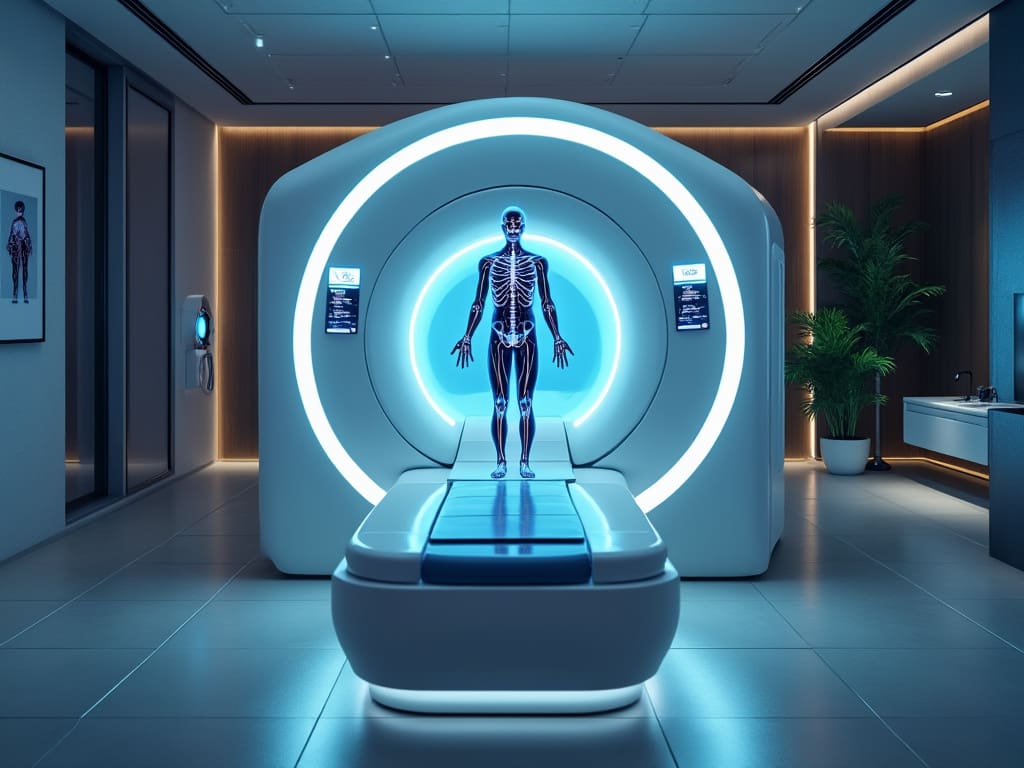The future of medical imaging lies in creating a system that is faster, less intrusive, and more informative than current technologies. By integrating cutting-edge advancements in imaging, artificial intelligence (AI), and patient-centered design, we can develop a full-body scanning system that provides detailed analytics of all bodily systems efficiently.
1. Advanced Imaging Technologies
- Quantum Magnetic Resonance Imaging (Quantum MRI):
- How it Works: Utilizes quantum sensors, such as nitrogen-vacancy centers in diamonds, to detect magnetic fields at the nanoscale.
- Benefits: Offers higher resolution images at faster speeds compared to traditional MRI, capturing detailed information about tissues and organs.
- Terahertz Imaging:
- How it Works: Employs terahertz radiation to penetrate tissues without the harmful effects of ionizing radiation.
- Benefits: Provides high-resolution images of soft tissues, aiding in the detection of cancers and other abnormalities.
- Multispectral Optoacoustic Tomography (MSOT):
- How it Works: Combines laser optics and ultrasound to visualize optical contrast in tissues.
- Benefits: Allows for real-time imaging of physiological processes, such as blood flow and oxygenation.
2. AI-Powered Image Processing and Analysis
- Real-Time Image Reconstruction:
- How it Works: AI algorithms reconstruct images instantly as data is acquired.
- Benefits: Significantly reduces scan times and allows for immediate review.
- Automated Anomaly Detection:
- How it Works: Machine learning models trained on vast datasets identify abnormalities.
- Benefits: Enhances diagnostic accuracy and reduces reliance on manual interpretation.
- Predictive Health Analytics:
- How it Works: AI analyzes patterns to predict potential health issues before symptoms arise.
- Benefits: Enables proactive healthcare and personalized treatment plans.
3. Patient-Centric Design
- Open-Architecture Scanners:
- How it Works: Designs that eliminate the enclosed tunnel, using rotating gantries or stationary field generators.
- Benefits: Reduces claustrophobia and accommodates patients of all sizes and mobility levels.
- Silent Scanning Technology:
- How it Works: Reduces noise through advanced gradient coil designs and pulse sequences.
- Benefits: Improves patient comfort and reduces anxiety during scans.
- Motion-Tolerant Imaging:
- How it Works: AI algorithms correct for patient movement in real-time.
- Benefits: Eliminates the need for patients to remain perfectly still, beneficial for pediatric and elderly patients.
4. Comprehensive System Integration
- Hybrid Imaging Modalities:
- How it Works: Combines MRI with PET, CT, or ultrasound in a single session.
- Benefits: Provides both anatomical and functional information, enhancing diagnostic capabilities.
- Whole-Body Coverage with Focused Detail:
- How it Works: Scans the entire body while allowing for high-resolution imaging of specific areas as needed.
- Benefits: Offers a complete health overview without sacrificing detail where it’s most critical.
5. Efficient Workflow and Accessibility
- Accelerated Scan Protocols:
- How it Works: Uses techniques like compressed sensing and parallel imaging.
- Benefits: Reduces scan times from hours to minutes without compromising image quality.
- Cloud-Based Data Management:
- How it Works: Stores imaging data securely in the cloud for easy access.
- Benefits: Facilitates collaboration among healthcare providers and empowers patients with access to their health data.
- User-Friendly Interface:
- How it Works: Intuitive controls and AI-guided setup streamline operation.
- Benefits: Reduces technician workload and minimizes the potential for human error.
6. Advanced Diagnostics and Analytics
- Biochemical and Molecular Imaging:
- How it Works: Detects biochemical changes at the molecular level using specialized contrast agents.
- Benefits: Identifies diseases in their earliest stages by observing metabolic processes.
- Personalized Health Reports:
- How it Works: AI generates comprehensive reports tailored to the individual’s health profile.
- Benefits: Provides actionable insights and recommendations for both patients and clinicians.
- Integration with Electronic Health Records (EHR):
- How it Works: Seamlessly updates patient records with imaging data and analytics.
- Benefits: Enhances continuity of care and informed decision-making.
7. Safety and Sustainability
- Non-Ionizing Radiation:
- How it Works: Utilizes imaging modalities that do not expose patients to harmful radiation.
- Benefits: Safe for repeated use, including vulnerable populations like pregnant women and children.
- Energy-Efficient Systems:
- How it Works: Incorporates energy-saving technologies and standby modes.
- Benefits: Reduces operational costs and environmental impact.
- Modular Upgradability:
- How it Works: Design allows for components to be updated individually.
- Benefits: Extends system lifespan and adapts to future technological advancements.
8. Collaboration with Wearable and Remote Monitoring Devices
- Data Integration:
- How it Works: Combines scan data with information from wearables like smartwatches and fitness trackers.
- Benefits: Provides a holistic view of the patient’s health over time.
- Telemedicine Compatibility:
- How it Works: Enables remote consultations and second opinions through secure connections.
- Benefits: Increases access to specialist care regardless of location.
Conclusion
By harnessing the latest advancements in imaging technology and AI, this reimagined full-body scanning system offers a transformative approach to medical diagnostics. It provides rapid, detailed insights into all bodily systems in a patient-friendly manner. Such a system not only enhances the efficiency and accuracy of diagnostics but also empowers patients and healthcare providers with actionable health analytics, paving the way for personalized medicine and proactive healthcare management.
